|
|
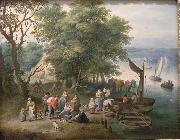 |
Theobald Michau
|
|
Michau (1676 Tournai - Antwerp 1765) was a conservative Flemish painter of landscapes, more famous in his own time than he is today. He was a pupil of Lucas Achtschellinck.
Subjects of the country festivals (Kermesse) that were popularized by David Teniers, father and son to the extent that paintings and tapestries showing such rustic themes were called Tenieres. Michau painted designs and perhaps provided full-scale cartoons for tapestry weavers, for surviving records of the Brussels tapestry workshop of Pieter van der Borcht record Teniers peints par le fameux Sr Michau, such Teniers-like subjects painted by "the famous Sieur Michau".
Among his work, on wooden or copper panels, in public collections are the Summer and Winter landscapes in Vienna
|
|
|
|
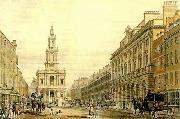 |
thomas malton
|
|
Thomas Malton (1748 - 7 March 1804), the younger, was an English painter of topographical and architectural views, and an engraver. J M W Turner and Thomas Girtin were amongst his pupils. He is designated the younger to differentiate him from his father Thomas Malton the elder.
Malton was born in London, the son of Thomas Malton the elder, a notable architectural draughtsman and writer on geometry. He was with his father during the latter's residence in Dublin, Ireland, and then passed three years in the office of James Gandon the architect, in London. In 1774 Malton received a premium from the Society of Arts. He entered the Royal Academy and in 1782 gained a gold medal for his design for a theatre. In 1773 he sent the Academy a view of Covent Garden, and was afterwards a constant exhibitor, chiefly of views of London streets and buildings, drawn in Indian ink and tinted. In these there is little attempt at pictorial effect, but their extreme accuracy in the architectural details renders them of great interest and value as topographical records. They are enlivened with groups of figures, in which Malton is said to have been assisted by Francis Wheatley.
After leaving Ireland, Malton appears to have always lived in London - with the exception of a brief stay at Bath in 1780. From 1783 to 1789 he resided in Conduit Street (London), and at an evening drawing class which he held there, received as pupils Thomas Girtin and young J M W Turner, whose father brought him to be taught perspective. Turner paid tribute to him in later life by saying My real master was Tom Malton.
In 1791 Malton removed to Great Titchfield Street, and finally, in 1796, to Long Acre. He made a few of the drawings for Watts's Seats of the Nobility and Gentry published in 1779, and executed some large aquatints of buildings in both London and Bath, being one of the first to avail himself of the newly introduced art of aquatinta for the purpose of multiplying copies of his views. He also painted some scenes for Covent Garden Theatre.
In 1792 Malton published the work by which he is now best known, A Picturesque Tour through the Cities of London and Westminster, illustrated with a hundred aquatint plates. Between 1798 -1800 he produced Views from Cambridge, and at the time of his death was engaged upon a similar series of views of Oxford, some of which appeared in parts in 1802, and were reissued with others in 1810.
Malton died in Long Acre, London on 7 March 1804, leaving a widow and six children. His portrait, painted by Gilbert Stuart, was engraved by William Barney in 1806. A portrait of his son Charles, when a child, drawn by Sir Thomas Lawrence, was engraved by F C Lewis.
Malton's brother James Malton was also a notable artist, draughtsman and engraver. |
|
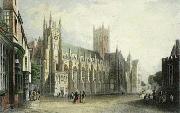 |
Thomas Mann Baynes
|
|
(1794 ?C 1876) was a London born English artist known for his drawings and watercolours of landscapes, buildings and outdoor events. Many of his subjects were engraved and published, generally in London, and these include a notable panorama of the River Thames, which was drawn from nature and engraved on stone. He was the son of James Baynes, a noted watercolour artist.
Baynes also produced views of Liverpool and Ireland, and appears to have made a successful living as a printer prior to his death in 1854. His son Fredrick Thomas Baynes (1824-1874) was also a noted watercolour artist.
|
|
|
|
|
|
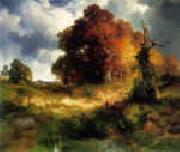 |
Thomas Moran
|
|
b1837 UK d1926
Thomas Moran Locations
Thomas Moran (February 12, 1837 - August 25, 1926) from Bolton, England was an artist of the Hudson River School who often painted the Rocky Mountains. Thomas Moran's vision of the Western landscape was critical to the creation of Yellowstone National Park. Thomas Moran along with Albert Bierstadt, Thomas Hill, and William Keith are sometimes referred to as belonging to the Rocky Mountain School of landscape painters because of all of the Western landscapes made by this group.
|
|
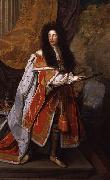 |
Thomas Murray
|
|
Wikipedia does not have an article with this exact name. Please search for Thomas Murray (artist) in Wikipedia to check for alternative titles or spellings. |
|
|
|
|
|
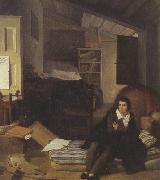 |
Tommaso Minardi
|
|
1787-1871
Italian painter, draughtsman, teacher and theorist. He studied drawing with the engraver Giuseppe Zauli (1763-1822) who imbued Minardi with his enthusiasm for 15th-century Italian art and introduced him to his large collection of engravings after the work of Flemish artists such as Adriaen van Ostade. However, Minardi was strongly influenced by the Neo-classical painter Felice Giani, who ran a large workshop in Faenza, and whose frescoes of mythological scenes (1804-5) at the Palazzo Milzetti he saw being painted. In 1803 he went to Rome on an annual stipend provided by Count Virgilio Cavina of Faenza (1731-1808), and he received (1803-8) additional financial assistance from the Congregazione di S Gregorio. He was given the use of Giani's studio and through him met Vincenzo Camuccini who, with Canova, dominated the artistic establishment in Rome at that time. Although Minardi learnt the precepts of Neo-classicism from Camuccini, he did not share his interest in heroic art. His first works done in Rome show his interest in the theme of master and acolyte. In Socrates and Alcibiades (1807; Faenza, Pin. Com.), for example, he has included himself among a group of elderly philosophers and young students who are placed on either side of a portrait bust of Zauli. He sent this drawing to his patrons, the Congregazione di S Gregorio, no doubt to reassure them of his aptitude and moral correctness. Supper at Emmaus (c. 1807; Faenza, Pin. Com.) was another painting destined for the same patrons. The confined pictorial space, with a single source of light entering through a small window, and the casual poses of the figures are reminiscent of Flemish art and of the works of the northern Caravaggisti, familiar to the artist through engravings. |
|
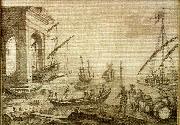 |
ulrika melin
|
|
Ulrika Drufva, född 1767, död 1834, var en svensk textilkonstnär, ledamot av Fria konsternas Akademi.
Ulrika Melin var dotter till major Lars Melin, syster till generalmajor Henrik Georg Melin och från 1788 gift med ståthållaren på Västerås slott Peter Thure Gerhard Drufva. Melin var konstnär och "egde en ovanlig skicklighet uti att sy landskap". Hon invaldes i akademin år 1784 för ett arbete i vit satin, inspirerad av Claude Lorrain. |
|
|
|
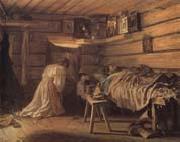 |
Vassily Maximov
|
|
Russian 1844-1911,was a Russian painter, a prominent member of the Peredvizhniki group. Maximov was born to a peasant family in the village of Lopino near Novaya Ladoga. He became an orphan early and worked for an Iconpainting shop, where he first learned to paint. In 1863 he entered the Imperial Academy of Arts and in 1864 he became a member of an Artel of Artists created by P.N. Krestonovtsev by the example of Ivan Kramskoi. The artel existed only one year and was then disbanded. Maximov painted the Sick Child (1864) at that time, when received a Gold Medal of the Academia. He completed all the courses of the Academy in three years. In 1865 he (like the group of fourteen led by Ivan Kramskoi had done earlier) refused to take part in the competitions for the Major Gold Medal by Academia. He argued that he did not need to study abroad (that was a part of the prize) but rather would study the Russian village. Indeed, after graduation from the Academia he moved to the village of Shubino, in the gubernia of Tver, where he painted the peasant life, earning money as a painting teacher of the Princes Golenischev Kutuzov (descendants of Mikhail Illarionovich Kutuzov). His painting Grandmother tales (1867) was shown at a Peredvizhniki exhibition, where it won a prize and was bought by Pavel Tretyakov. In 1872 he was admitted to the Peredvizhniki group, and soon became one of its most prominent and rigorous members. Ilya Yefimovich Repin described Maximov as the most uncrushable stone in the foundation of peredvizhnechestvo. Maximov painted many paintings of the peasant life. In the last twenty years of his life, realism paintings fell out of fashion. Maximov still painted almost exclusively scenes of the peasant lives that had almost no buyers. The artist lived a life full of poverty and illnesses. He died in Saint Petersburg. |
|
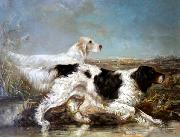 |
Verner Moore White
|
|
Verner Moore White (October 5, 1863 - August 30, 1923), born Thomas Verner Moore White but informally known as Verner White, was an American landscape and portrait painter. White painted works for many of the business and political leaders of his time including commissions for three United States Presidents.
|
|
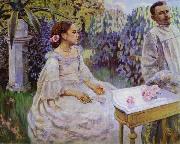 |
Victor Borisov-Musatov
|
|
(Russian), (April 14 [O.S. April 2] 1870 - November 8 [O.S. October 26] 1905) was a Russian painter, prominent for his unique Post-Impressionistic style that mixed Symbolism, pure decorative style and realism. Together with Mikhail Vrubel he is often referred as the creator of Russian Symbolism style.
Victor Musatov was born in Saratov, Russia (he added the last name Borisov later). His father was a minor railway official who had been born as a serf. In his childhood he suffered a spinal injury, which made him humpbacked for the rest of his life. In 1884 he entered Saratov real school, where his talents as an artist were discovered by his teachers Fedor Vasiliev and Konovalov.
He was enrolled in the Moscow School of Painting, Sculpture and Architecture in 1890, transferring the next year to the Imperial Academy of Arts in Saint-Petersburg, where he was a pupil of Pavel Chistyakov. The damp climate of Saint-Petersburg was not good for Victor's health and in 1893 he was forced to return to Moscow and re-enroll to the Moscow School of painting, sculpturing and architecture. His earlier works like May flowers, 1894 were labelled decadent by the school administration, who sharply criticised him for making no distinction between the girls and the apple trees in his quest for a decorative effect. The same works however were praised by his peers, who considered him to be the leader of the new art movement.
The Pool. 1902In 1895 Victor once again left Moscow School of painting, sculpturing and architecture and enrolled in Fernand Cormon's school in Paris. He studied there for three years, returning in summer months to Saratov. He was fascinated by the art of his French contemporaries, and especially by the paintings of "the father of French Symbolism" Pierre Puvis de Chavannes and by the work of Berthe Morisot.
In 1898 Borisov-Musatov returned to Russia and almost immediately fell into what it is called "fin de siecle nostalgia". He complained about "the cruel, the truly iron age", "dirt and boredom", "devil's bog", and he had acute money problems that were somewhat alleviated only in the last years of his life when collectors started to buy his paintings. Musatov's response was creating a half-illusory world of the 19th century nobility, their parks and country-seats. This world was partially based on the estate of princes Prozorvky-Galitzines Zubrilovka and partially just on Musatov's imagination. Borisov-Musatov also abandoned oil-paintings for the mixed tempera and watercolor and pastel techniques that he found more suitable for the subtle visual effects he was trying to create.
|
|
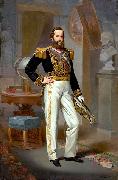 |
Victor Meirelles
|
|
Victor Meirelles de Lima (August 18, 1832 -February 22, 1903) was a 19th century painter. He studied art in Paris but painted most of his works in and about his native Brazil. His religious and military paintings helped him become one of the most popular and celebrated Brazilian painters. His The first Mass in Brazil was the first Brazilian painting to be accepted in the Salons of Paris and is one of the most well known paintings in his native country, being reproduced in every book of History for elementary schools. |
|
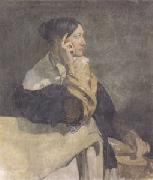 |
Victor Mottez
|
|
Lille 1809-Bievres (Essonne)1897
.was a French fresco painter, painter and portraitist. His father was passionate about art and painted himself. Sent to Paris with a pension for some years, Victor was recalled due to the poor state of his father's finances and his studies were cut short. He followed courses at the École de dessin in Lille and worked under the direction of his father and his father's painter friends such as Édouard Lienard, student of Jacques-Louis David. He returned to Paris from 1828 to 1829 to enter the École des Beaux-Arts and at first studied under the direction of François-Édouard Picot, then as a free student of Dominique Ingres. The Mottez family was highly religious and devoted to the House of Bourbon, and so the July Revolution in 1830 came as a catastrophe to them. Victor was again recalled to Lille by his father and married shortly afterwards. From there he made many trips, of which the longest and most notable was that to Italy and he came to consider its old masters as the absolute masters of painting. In Rome he met Ingres again - Ingres liked him very much and often gave him advice. His Christ in the Tomb (now in the glise Sainte-Catherine de Lille) and The Martyrdom of Saint Stephen (now in the glise Saint-Étienne de Lille) date to this era. Also on this trip to Italy he became hugely interested in fresco art - Mottez painted his wife Julie in this medium and, showing Ingres the end result, pulled it off the wall at Ingres' request (it was later given to the Louvre by Mottez's two children). Returning to France in 1838, he set up shop in Paris and exhibited at the Paris Salons, especially turning more and more towards the neglected genre of frescoes, notably religious ones. He also translated the Treatise by the 14th century Florentine painter Cennino Cennini and learned from his techniques. His most remarkable works are those for churches (at Église Saint-Germain-l'Auxerrois in the 1840s, and at the Saint-Severin in the 1850s), which were admired by Ingres and Delacroix. However, the clergy's hostility to them, the materials used, the saltpeter walls and their situation all meant that they were already deteriorated by the end of the 19th century and are now largely lost (except for Saint Martin cutting his cloak in two at St-Germain l'Auxerrois), though Mottez's cartoons for them survive. During the same years he frequented the Bertins' salon, alongside the main writers and artists of the time (a sketch of his for a portrait of Victor Hugo survives). He produced two frescoes for this salon, destroyed in 1854. After the 1848 Revolution Mottez set out for the United Kingdom, where he produced several portraits of British nobles and personalities and the exiled minister François Guizot, which were exhibited at the Royal Academy salons. |
|
|
|
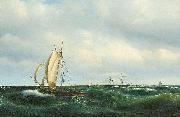 |
Vilhelm Melbye
|
|
(14 May 1824 - 6 October 1882) was a Danish marine artist, the brother of Anton Melbye and Fritz Melbye. He worked in London from 1853 to 1866 and, over the course of his career, painted seascapes, coastal and harbor scenes, sailing vessels and topographical subjects in many parts of Europe, especially in the Mediterranean region.
Knud Frederik Vilhelm Hannibal Melbye was born on 14 May 1824 in Elsinore, Denmark. He first trained to become a merchant but then turned to painting, studying under his older brother Anton, already an established marine painter, and attending the Royal Danish Academy of Fine Arts from 1844 to 1847. He also took private classes in perspective drawing with Carl Dahl.
In 1847, he went on his first journey, to Iceland aboard the corvette Valkyrien, and the following year he traveled to Paris by way of Desseldorf. In Paris he studied with Theodore Gudin (1802 - 1880) before returning to Denmark in 1849.
From 1853 to 1866, he lived in London and it was here he changed his name from Vilhelm to Wilhelm.
He was appointed Professor at the academy in Copenhagen in 1880 but died in 1882 in Roskilde. He is interred at Assistens Cemetery in Copenhagen.
|
|
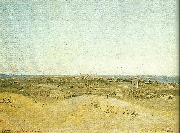 |
villelm melbye
|
|
Danish, 1824-1882
The brother of Anton and Fritz, both Danish artists, Vilhelm Knut Frederik Melbye was born in Denmark and would finish his career as a Professor in the Copenhagen Academy, appointed in 1880. His years between would see him work out of the important venues of Dusseldorf, Venice, Paris and London.
His paintings may almost be used as a travelogue to his career. Working in the Netherlands and paintings scenes of the North and Black Seas through the late 1840s, he exhibited regularly at Charlottenborg in Copenhagen. Melbye lands in London by the early 1850s and ??anglicizes?? his signature to Wilhelm Melby. Paintings by him of Gibraltar and the Italian Mediterranean are in prominent public collections with dates from 1854-62. British subjects reappear in the 1860s, and in 1878, he exhibits at the Parisian Academies. Some later works are signed with initials or his given name once again.
The heart of all his paintings is his obvious attraction to the coastal harbors and marine settings of Europe. They dominate his output, and are compositions full of realistic and dramatic elements emphasizing humanity??s maritime efforts. Cool light, layered shadows and a talent for translating visual depth are noticeable elements in his paintings.
|
|
|
|
|
|
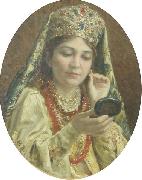 |
Vladimir Makovsky
|
|
(Russian: 26 January (greg.: 7 February) 1846, Moscow - 21 February 1920, Petrograd) was a Russian painter, art collector, and teacher.
Portrait by Vladimir Makovsky of Empress Maria Fyodorovna. Gatchina Palace, 1885Makovsky was the son of collector, Yegor Ivanovich Makovsky, who was one of the founders of the Moscow Art School. Vladimir had two brothers, Nikolai Makovsky and Konstantin Makovsky, and one sister, Alexandra Makovsky, all of whom were famous painters. Vladimir studied at the Moscow School of Painting, Sculpture, and Architecture. He finished his studies in 1869 and the following year became one of the founding members of the Association of Travelling Art Exhibitions, where his many years of prolific work brought him to a leading position
Makovsky's work was defined by a perpetual humor as well as blatant irony and scorn. During the seventies his paintings dealt primarily with small-town folk. His pictures, "The Grape-juice Seller" (1879), "Fruit-Preserving" (1876) and "The Congratulator" (1878) depict various scenes where the mood is finely conceived and almost laughter-inducing. Other works of his, such as "The Benefactor" (1874) and "The Convict" (1878) are profoundly socially-conscious. In them, Makovsky either criticizes the false sympathy of the aristocracy towards the poor, or draws attention to the oppression and persecution by the tsarist gendarmerie. In 1878, he became an academician.
In the eighties, during the time of Russian "democratic" painting, Makovsky produced some of his most valued works. In 1882, he was made professor at the Moscow Art School after the death of Vasili Perov. Some of Makovsky's greatest works of this period include "In the Ante-room of the Court of Conciliation" (1880), "The Released Prisoner" (1882), and "The Collapse of the Bank" (1881). From the end of the 1880s, Makovsky began to produce more gloomy works. Quintessential works of this period include "You Shall Not Go" (1892), and "On the Boulevard" (1888).
In 1894, Makovsky became Rector of the Preparatory school of the Academy of Art. After the First Russian Revolution, he painted "January 9, 1905, on Vasilyev Island" in which he depicts the armed police firing at defenseless people. In another painting "The Sacrifices on the Khodyn Field" in which a thousand people lost their lives during the coronation ceremony in 1896 of Nicholas II, he again stood uncompromisingly on the side of the oppressed people. After the 1917 October Revolution, Makovsky helped carry over the realist traditions to the early stages of Socialist Realism.
|
|
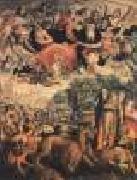 |
VOS, Marten de
|
|
Flemish painter (b. 1532, Antwerpen, d. 1603, Antwerpen).
Flemish painter and draughtsman. Together with the brothers Ambrosius Francken I and Frans Francken I, he ranks among the most important painters of altarpieces in Antwerp during the 1590s. Due, in part, to the Counter-Reformation, there was a renewed demand for altarpieces to replace those lost during iconoclastic riots in 1566 or the reformist movement of 1581. De Vos produced works for, among others, the Old Crossbowmen, the Brabant Coiners, the Antonites, the wine merchants and the Guild of St Luke. The importance of these works would seem to suggest that, after the deaths of Pieter Bruegel I in 1569 and Frans Floris in 1570, de Vos was considered, with some justification, the most important figure painter in Antwerp before Rubens. He was also a prolific draughtsman, especially during the first half of the 1580s, when the Calvinists were in power in Antwerp. During this period he provided numerous designs for print publishers, such as Peeter Baltens, Frans van Beusecom, the widow of Hieronymus Cock, Adriaen Collaert, Phillip Galle, Willem van Haecht, Eduard van Hoeswinkel, Gerard de Jode, Hans van Luyck and Johannes Baptista Vrints. This increased activity is probably indicative of the economic recession and a dwindling market for paintings (especially of religious themes). A total of some 1600 prints were produced after designs by de Vos, an output three times that of Maarten van Heemskerck. De Vos's drawings have been praised (see Mielke) for their lively, |
|
|
|
|
|
|
|
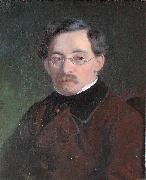 |
Wilhelm Marstrand
|
|
(24 December 1810 - 25 March 1873), painter and illustrator, was born in Copenhagen, Denmark to Nicolai Jacob Marstrand, instrument maker and inventor, and Petra Othilia Smith. Marstrand is one of the most renowned artists belonging to the Golden Age of Danish Painting.
Marstrand studied at Copenhagen's Metropolitan School (Metropolitanskolen), but had little interest in books, and left around 16 years of age. Christoffer Wilhelm Eckersberg, painter and professor at the Royal Danish Academy of Art (Det Kongelige Danske Kunstakademi) in Copenhagen, was a close friend of Wilhelm's father, and it was to all appearance Eckersberg who recommended an artistic career for young Wilhelm. Wilhelm had already shown artistic talent, tackling difficult subjects such as group scenes with many figures and complicated composition.
At 16 years of age Marstrand thus began his studies at the Academy under Eckersberg, attending the school from 1826 to 1833. Although his interests had a firm hold in genre themes - depiction of the daily life he observed around him in Copenhagen's streets, especially middle class society - he would soon reach for the pinnacle of Academic acceptability: the history painting.
History painting displayed what was grand - classical themes from mythology and history, rather than daily life. The traditions, and the taste of traditional art critics, strongly favored it. It was therefore something to strive for, in spite of Marstrand's equal skill at depicting more modest themes, and of the enjoyment he had in portraying the crowds, the diversions of the city, and the humor and story behind the hustle and bustle. Marstrand's creative production would, through many paintings and illustrations made not only during the 1830s but throughout his life, never abandon this inclination toward displaying the simple life of his times.
At the same time Christian Waagepetersen, wine merchant to the Danish court and supporter of the arts, also became an important patron for Marstrand during this early period. His painting "A musical evening party" (Et musikalsk aftenselskab) (1834), depicts such an occasion at the home of Waagepetersen, and was an important transition painting for Marstrand.
Despite an unmistakably growing recognition, Marstrand never received the Academy's gold medal. This medal was coveted not only for its great prestige, but also because it came with a travel stipend for furthering the laureate's artistic training. Marstrand's attempts at winning the medal were unsuccessful both in 1833 with his neoclassical "Flight to Egypt" (Flugten til Ægypten) and in 1835 with "Odysseus and Nausikaa". This was a disappointment, as he had won both available silver medals in 1833.
|
|
|
|
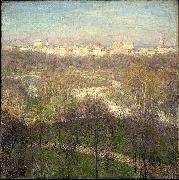 |
Willard Leroy Metcalf
|
|
(July 1, 1858 - March 9, 1925) was an American artist born in Lowell, Massachusetts. He studied at the School of the Museum of Fine Arts, Boston, and later attended Academie Julian, Paris. After early figure-painting and illustration, he became prominent as a landscape painter. He was one of the Ten American Painters who in 1897 seceded from the Society of American Artists. For some years he was an instructor in the Womans Art School, Cooper Union, New York, and in the Art Students League, New York. In 1893 he became a member of the American Watercolor Society, |
|
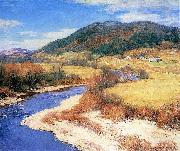 |
Willard Metcalf
|
|
Willard Leroy Metcalf (July 1, 1858 - March 9, 1925) was an American artist born in Lowell, Massachusetts. He studied at the School of the Museum of Fine Arts, Boston, and later attended Academie Julian, Paris. After early figure-painting and illustration, he became prominent as a landscape painter. He was one of the Ten American Painters who in 1897 seceded from the Society of American Artists. For some years he was an instructor in the Womans Art School, Cooper Union, New York, and in the Art Students League, New York. In 1893 he became a member of the American Watercolor Society, New York. Generally associated with American Impressionism, he is also remembered for his New England landscapes and involvement with the artists' colony at Old Lyme, Connecticut.
Born into a working-class family, Metcalf began painting in 1874. In 1876 he opened a studio in Boston, and received a scholarship at the Boston Museum school, where he studied until 1878. In 1882 he held an exhibition at the J. Eastman Chase Gallery in Boston, the sales from which financed a study trip abroad.[1]
Metcalf left for Europe in September 1883, and did not return to the United States until late 1888. During that time he traveled and painted, studying first in Paris with Gustave Boulanger and Jules-Joseph Lefebvre, subsequently going to England and Pont-Aven, Brittany. In the winter of 1884 he apparently met John Twachtman in Paris, and painted at Grez-sur-Loing alongside other American artists, including Theodore Robinson. His landscapes at this time were traditional renditions of peasant scenes, in the manner of Jean Millet.[2] By 1886 Metcalf was painting in Giverny, evidently the first American painter to visit there.[2] Soon thereafter he traveled to Algeria and Tunisia, returning to Giverny in the summers of 1887 and 1888, in the company of other American painters.
|
|
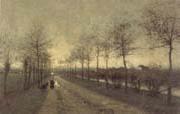 |
Willem Maris
|
|
Dutch Painter, 1844-1910
Brother of Jacob Maris. He received his training as a painter from his brothers, Jacob Maris and Matthijs Maris. Although he briefly attended evening classes at the Academie in The Hague and was advised by the animal painter Pieter Stortenbeker (1828-98), he was basically self-taught; he was the only self-made man in the circle of Hague school artists. In 1862 he visited Oosterbeek where he met Anton Mauve, with whom he established a long friendship. In the same year he first entered a painting, Cows on the Heath (untraced), in the Tentoonstellung van Levende Meesters in Rotterdam. The themes of cows at pasture and ducks by the side of a ditch, which characterized the Dutch polder landscape in summer, became his hallmark. In the following year he exhibited Cows by a Pool (The Hague, Gemeentemus) in The Hague; it received discouraging reviews, as did the picture entered by his brother Matthijs. Painted in 1863, this work already employs Willem main motif and shows his attention to the handling of light (with effects of haze and backlighting). |
|
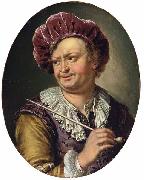 |
Willem van Mieris
|
|
(3 June 1662, Leiden - 26 January 1747, Leiden) was a Dutch painter. He was a son of Frans van Mieris sr. and brother of Jan van Mieris.
His works are extremely numerous, being partly imitations of the paternal subjects, or mythological episodes, which Frans habitually avoided. In no case did he come near the excellence of his sire.
van Mieris has works in the Victoria and Albert Museum as well as Cheltenham and Derby Museum and Art Gallery
|
|
|
|
|
|
|
|
|
|
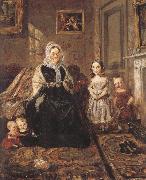 |
william holman hunt,o.m.,r.w.s
|
|
1827-1910
English painter. He worked as an office clerk in London from 1839 to 1843, attending drawing classes at a mechanics' institute in the evenings and taking weekly lessons from the portrait painter Henry Rogers. Holman Hunt overcame parental opposition to his choice of career in 1843, and this determined attitude and dedication to art could be seen throughout his working life. In July 1844, at the third attempt, he entered the Royal Academy Schools. His earliest exhibited works, such as Little Nell and her Grandfather (exh. British Institution, 1846; Sheffield, Graves A.G.), reveal few traces of originality, but the reading of John Ruskin's Modern Painters in 1847 was of crucial importance to Holman Hunt's artistic development. It led him to abandon the ambitious Christ and the Two Marys (Adelaide, A.G. S. Australia) in early 1848, when he realized its traditional iconography would leave his contemporaries unmoved. His next major work, the Flight of Madeline and Porphyro during the Drunkenness Attending the Revelry (1848; London, Guildhall A.G.), from John Keats's 'Eve of St Agnes', though displaced into a medieval setting, dramatized an issue dear to contemporary poets and central to Holman Hunt's art: love and youthful idealism versus loyalty to one's family. His first mature painting, it focuses on a moment of psychological crisis in a cramped and shallow picture space. |
|
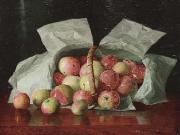 |
William J. McCloskey
|
|
painted Lady Apples in Overturned Basket. Signed W.J. McCloskey in 1941
United States (1859- 1941 ) - Painter |
|
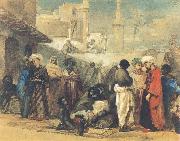 |
William James Muller
|
|
British Painter, 1812-1845, English landscape and figure painter, was born at Bristol, his father, a Prussian, being curator of the museum. He first studied painting under JB Pyne. His early subjects deal mainly with the scenery of Gloucestershire and Wales, and he learned much from his study of Claude, Ruysdael, and earlier landscape-painters. In 1833 he figured for the first time in the Royal Academy with his "Destruction of Old London Bridge--Morning," and next year he made a tour through France, Switzerland and Italy. Four years later he visited Athens, extending his travels to Egypt, and in the sketches executed during this period and the paintings produced from them his power and individuality are apparent. Shortly after his return he left Bristol and settled in London, where he exhibited regularly. In 1840 he again visited France, where he executed a series of sketches of Renaissance architecture, twenty-five of which were lithographed and published in 1841, in a folio entitled "The Age of Francis I. of France." In 1843 he accompanied, |
|
|
|
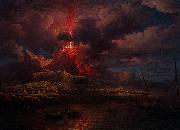 |
William Marlow
|
|
(1740 - 14 January 1813) was a British landscape and marine painter and etcher.
Marlow was born in Southwark in London, and studied for 5 years under the marine painter Samuel Scott, and also at the St. Martin's Lane Academy, London.
He became a member of the Incorporated Society of Artists, and from 1762 to 1764 contributed to their exhibitions in Spring Gardens. He was employed in painting views of country houses.
From 1765 to 1768, on the advice of the Duchess of Northumberland, he travelled in France and Italy. On his return to Britain he renewed his contributions to the Society of Artists, and took up residence in Leicester Square, London - he was made a Fellow of the Society in 1771.
In 1788 he moved to Twickenham, and started to exhibit at the Royal Academy, showing works regularly until 1796, and again, for the last time, in 1807, when he exhibited Twickenham Ferry by Moonlight.
Marlow died in Twickenham on 14 January 1813.
|
|
|
|
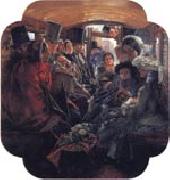 |
William Maw Egley
|
|
English painter , (1826-1916)
was a British artist of the Victorian era. The son of the miniaturist William Egley, he studied under his father. His early works were illustrations of literary subjects typical of the period, such as Prospero and Miranda from The Tempest. These were similar to the work of The Clique. William Powell Frith, one of The Clique, hired Egley to add backgrounds to his own work. Egley soon developed a style influenced by Frith, including domestic and childhood subjects. Most of his paintings were humorous or "feelgood" genre scenes of urban and rural life, depicting such subjects as harvest festivals and contemporary fashions. His best known painting, Omnibus Life in London (Tate Gallery) is a comic scene of people squashed together in the busy, cramped public transport of the era. Egley always showed great interest in specifics of costume, to which he paid detailed attention, but his paintings were often criticised for their hard, clumsy style. In the 1860s Egley adopted the fashion for romanticised 18th century subjects. |
|
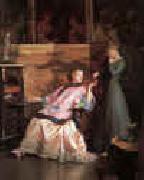 |
William McGregor Paxton
|
|
1869-1941
William McGregor Paxton Gallery
William McGregor Paxton (June 22, 1869 ?C 1941) was an American Impressionist painter.
Born in Baltimore, the Paxton family came to Newton Corner in the mid-1870s, where William's father James established himself as a caterer. At 18, William won a scholarship to attend the Cowles Art School, where he began his art studies with Dennis Miller Bunker. Later he studied with Jean-L??on G??rôme in Paris and, on his return to Boston, with Joseph DeCamp at Cowles. There he met his future wife Elizabeth Okie, who also was studying with DeCamp. After their marriage, William and Elizabeth lived with his parents at 43 Elmwood Street, and later bought a house at 19 Montvale Road in Newton Centre.
Paxton, who is best known as a portrait painter, taught at the Museum School from 1906 to 1913. Along with other well known artists of the era, including Edmund Charles Tarbell and Frank Benson, he is identified with the Boston School.
Paxton was working on his last painting, a view of his living room at 19 Montvale Road, with his wife posing for him, when he was stricken with a heart attack and died at the age of 72. |
|
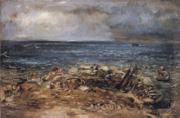 |
William Mctaggart
|
|
Scottish Painter,
1835-1910
was a Scottish landscape painter who was influenced by Impressionism. The son of a crofter, William McTaggart was born in the small village of Aros in Kintyre. He moved to Edinburgh at the age of 16 and studied at the Trustees' Academy under Robert Scott Lauder. He won several prizes as a student and exhibited his work in the Royal Scottish Academy, becoming a full member of the Academy in 1870. His early works were mainly figure paintings, often of children, but he later turned to land and seascape painting, inspired by his childhood love of the sea and the rugged, Atlantic-lashed west coast of his birth. The Storm, 1890, National Gallery of Scotland, Edinburgh.McTaggart was fascinated with nature and man??s relationship with it, and he strove to capture aspects such as the transient effects of light on water. He adopted the Impressionist practice of painting out of doors, and his use of colour and bold brushwork resemble qualities found in paintings by Constable and Turner, both artists whom he admired. McTaggart was skilled in the use of both oil and watercolour and, in addition to Kintyre seascapes, he also painted landscapes and seascapes in Midlothian and East Lothian. Many of his later works depict the Moorfoot Hills which could be seen from his house near Lasswade, which he moved to in 1889. |
|
|
|
|
|
|
|
|

